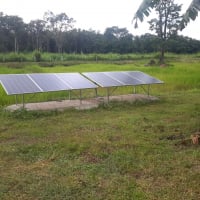Voltage on one lead of panel
ttpvt1
Registered Users Posts: 2 ✭
Can someone explain what the voltage on one lead (+ or -) of a solar panel is?
Obviously testing voltage from one lead to the other is Voc.
From experience, testing voltage from one lead to ground shows a small initial voltage which quickly dissipates to 0. Does this mean that touching the bare conductor from one lead of a panel (or string) presents no shock hazard?
Obviously testing voltage from one lead to the other is Voc.
From experience, testing voltage from one lead to ground shows a small initial voltage which quickly dissipates to 0. Does this mean that touching the bare conductor from one lead of a panel (or string) presents no shock hazard?
Comments
-
Assuming both conductors are isolated from ground there would be no potential difference of either with respect to ground, therefore no shock hazard by touching a single conductor.1500W, 6× Schutten 250W Poly panels , Schneider MPPT 60 150 CC, Schneider SW 2524 inverter, 400Ah LFP 24V nominal battery with Battery Bodyguard BMS
Second system 1890W 3 × 300W No name brand poly, 3×330 Sunsolar Poly panels, Morningstar TS 60 PWM controller, no name 2000W inverter 400Ah LFP 24V nominal battery with Daly BMS, used for water pumping and day time air conditioning.
5Kw Yanmar clone single cylinder air cooled diesel generator for rare emergency charging and welding. -
There may be some potential, but not generally hazardous. Those of us living in dry winter climates are quite familiar with potential differences being equalized, for example, after walking across a carpet and petting the cat
 Off-grid.
Off-grid.
Main system ~4kw panels into 2xMNClassic150 370ah 48v bank 2xOutback 3548 inverter 120v + 240v autotransformer
Night system ~1kw panels into 1xMNClassic150 700ah 12v bank morningstar 300w inverter -
Voltage measurements are always done with two leads to the meter. DMM (digital multimeters) are great devices, but they have one possible drawback. They draw very little current from whatever they are measuring (1-10 million Ohms resistance is common). That means any little leakage current or stored energy (capacitance, even just the stray capacitance of solar panel to the "world"). Add a little bit of static charge--You can "charge up" the solar panel and read the voltage with the DMM (you are seeing the meter slowly discharge the capacitance of the panel).
For debugging, a test load (like a light bulb) across your test points will either light the lamp (there is enough current to do this) or it will discharge the stray capacitance. You can even get DMMs that have a "low resistance" mode (it appears this meter uses a 3,000 Ohm resistor to discharge):
https://www.amazon.com/gp/product/B019CY4FB4/ref=ox_sc_saved_title_4?smid=ATVPDKIKX0DER
The above meter is also a DC/AC Current Clamp type meter... Current clamps are very easy (and safe) for debugging your systems.
Just to give you an idea, 5 mAmps (0.005 Amperes) or less through the human body is relatively safe (you can still feel the shock). Above that level, and you start to run the risk of stopping your heart (if the current goes through a leg and arm, for example).
Voltage wise, it depends on conditions (wet skin, salty water/sweat), Above ~12 volts can give you a shock. Above ~24 to 60 volts is a risk. Above 60 volts is "unsafe". But you have to have the current also (> 5 mAmps). For example, you can get shocked by walking across a carpet and get a multi thousand volt shock. But it will not kill you (not enough current/time).
So--Your question, can you get a shock (or get hurt) from touching one lead of solar panel. As always, the answer is "complicated"...
A single solar panel on the floor, no problem. A large solar array on a second story roof, there is a lot of capacitance and possible charging from the earth's natural magnetic electric field. In clear air, is (very roughly) 100 volts/meter... Get on a second story roof system, ~6 meters is ~600 volts of static charge. Add a thunderstorm in the area, and you can get many thousands of volts per meter of static charge.
https://en.wikipedia.org/wiki/Atmospheric_electricity
While you probably will not get killed... The surprise of an electric shock could knock somebody off a ladder if they are not careful (why electricians always use fiberglass ladders vs aluminum).
Once the solar panels are connected, there is usually some sort of ground reference somewhere... But you are still left with Voc/Vmp --- With enough current from the sun to still hurt you. Put two or more Voc~20 volt panel in series, and you now have enough voltage/current to actually be lethal (over 60 volts, over 5 mAmps).
-BillNear San Francisco California: 3.5kWatt Grid Tied Solar power system+small backup genset -
Thank you all for responding! I would like to follow up with a video showing voltage testing to ground from one lead of the module. Can anyone provide explanation for these results?
https://drive.google.com/open?id=1-BuW2SXaYP0Sdv8uDIDzj9Su5L9ZYRbs
https://drive.google.com/open?id=1AKjBydjs5EExaSEu9lLUC_vp8gi_-pLr
-
As Bill said, you have some capacitance to ground. And a high input impedance meter.
I am available for custom hardware/firmware development
-
I agree with Jonr that this appears to be discharging a static charge from the solar panel... Assuming:
- Meter is reading DC voltage (hard to tell, seems to auto select AC/DC and AC was flashing)
- Both the + and - leads of the panel were disconnected and you measured + (or -) to earth ground
Why ask that... Go back 40 years to my engineering classes (OK--Use Google to look stuff up).. Figure out the capacitance of a flat plate capacitor that is 1 meter square (39"x39") and 0.3 meters (~10") off the roof (other plate of capacitor) to pick nice round numbers.
https://www.daycounter.com/Calculators/Plate-Capacitor-Calculator.phtml
1,000,000 mm^2
300 mm between plates
k=1 for Air dielectric
0.000030 uF (10^-6 F)
http://referencedesigner.com/rfcal/cal_05.php
T=R*C
Assume 10,000,000 Ohms (10^6 Ohms) for meter (generally 1-10 MOhm) and 30 pF.
=0.3 seconds
I guessed a TC of somewhere around 1-2 seconds, and with pure guessing, got a TC around 0.3 seconds... Actually not too far off. If the panels were closer to the roof, or you had several panels in series or parallel, or we added the "better" dielectric of glass+roof tar and such... Could get closer to 1-2 second TC.
If you are actually trying to figure out if the circuit is energized--You need something like a 4-60 Watt 120 Volt filament lamp with socket+alligator clips to put across the circuit you are measuring (i.e., from + panel to grounded conduit).
Or use a different meter... A "Wiggy" Solenoid type meter (electric coil moves spring loaded plunger to read voltage--Takes fair amount of current to run):
https://www.amazon.com/BESTChoiceForYou-Solenoid-Tester-Voltage-Continuity/dp/B07CY29R2G
Or a DMM with "Low Resistance/Low Z" setting (I think it is around 3,000 Ohm resistor internally--Makes TC about 1/1,000 smaller/faster vs 10 MOhm meter--would discharge the your test in ~0.002 second TC):
https://www.amazon.com/gp/product/B019CY4FB4
If you are doing a lot of electrical work like this, having a method to make sure that circuits are not energized (lockouts, etc.)--And realizing that solar panels are energized when the sun is up (typically 20-50 volts for a single panel with X amps of drive)...
-BillNear San Francisco California: 3.5kWatt Grid Tied Solar power system+small backup genset
Categories
- All Categories
- 233 Forum & Website
- 141 Solar Forum News and Announcements
- 1.4K Solar News, Reviews, & Product Announcements
- 199 Solar Information links & sources, event announcements
- 900 Solar Product Reviews & Opinions
- 256 Solar Skeptics, Hype, & Scams Corner
- 22.5K Solar Electric Power, Wind Power & Balance of System
- 3.5K General Solar Power Topics
- 6.7K Solar Beginners Corner
- 1K PV Installers Forum - NEC, Wiring, Installation
- 2.1K Advanced Solar Electric Technical Forum
- 5.6K Off Grid Solar & Battery Systems
- 429 Caravan, Recreational Vehicle, and Marine Power Systems
- 1.1K Grid Tie and Grid Interactive Systems
- 656 Solar Water Pumping
- 816 Wind Power Generation
- 624 Energy Use & Conservation
- 623 Discussion Forums/Café
- 315 In the Weeds--Member's Choice
- 75 Construction
- 125 New Battery Technologies
- 108 Old Battery Tech Discussions
- 3.8K Solar News - Automatic Feed
- 3.8K Solar Energy News RSS Feed

